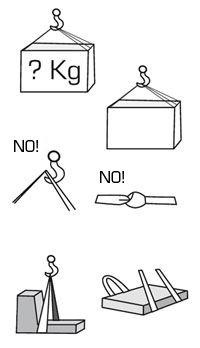Devices for Moving Loads
4. HAZARDS AND PREVENTIVE MEASURES IN THE HANDLING OF AUXILIARY ELEMENTS
FLAT FABRIC SLINGS
MAXIMUM WORKING LOAD OF FLAT SLINGS
| (% LOAD) | 100 % | 200 % | 140 % from 7º to 45º |
80 % | 100 % from 45º to 60º |
||
|---|---|---|---|---|---|---|---|
| M.W.L. | COLOURS | (WIDTH) |  |
 |
 |
 |
 |
| 1 T | PURPLE | 30 | 1000 | 2000 | 1400 | 800 | 1000 |
| 1,5 T | ORANGE | 50 | 1500 | 3000 | 2100 | 1200 | 1500 |
| 2 T | GREEN | 60 | 2000 | 4000 | 2800 | 1600 | 2000 |
| 2,5 T | WHITE | 75 | 2500 | 5000 | 3500 | 2000 | 2500 |
| 3 T | YELLOW | 90 | 3000 | 6000 | 4200 | 2400 | 3000 |
| 4 T | GREY | 120 | 4000 | 8000 | 5600 | 3200 | 4000 |
| 5 T | RED | 150 | 5000 | 10000 | 7000 | 4000 | 5000 |
| 6 T | BROWN | 180 | 6000 | 12000 | 8400 | 4800 | 6000 |
| 8 T | BLUE | 240 | 8000 | 15000 | 11200 | 6400 | 8000 |
| 10 T | ORANGE | 300 | 10000 | 20000 | 14000 | 8000 | 10000 |
PRACTICAL ADVICE WHEN USING FABRIC SLINGS
- Never overload slings.
- Bear in mind the way of loading and the tilt angle.
- Take the centre of gravity of the load into account.
- Never hook the belt or sling onto the sharp point of a hook.
- Protect the belt or sling from sharp edges.
- Never tie knots.
- Use belts or slings at temperatures ranging between - 40º and 100º C.
- If exposed to chemical agents, consult the manufacturer.
- Take the size of the crane hook into account. If necessary, use a reduction hook.
- Remove or replace belts and slings when the thread starts to appear.
- Do not suspend the load with a belt or sling along its entire length.
- Do not join up belts or slings with metal buckles or rings.





